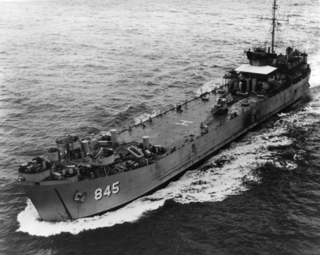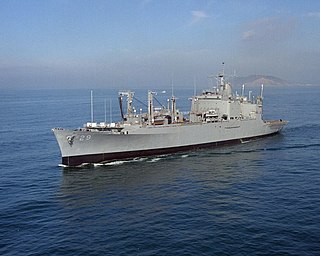 W
WThe first USS Astoria (SP-2005/AK-8) was a steel-hulled, coal-burning steam cargo ship of the United States Navy.
 W
WThe second USS Astoria (CL/CA-34) was a New Orleans-class cruiser of the United States Navy that participated in both the Battle of the Coral Sea and the Battle of Midway, but was then sunk in August 1942, at the Battle of Savo Island. Astoria was the first Astoria-class cruiser to be laid down but launched after and received a hull number higher than New Orleans, which the class was renamed for after Astoria sunk.
 W
WThe third USS Astoria (CL-90) was a Cleveland-class light cruiser of the United States Navy.
 W
WUSS Ault (DD-698) was an Allen M. Sumner-class destroyer in the United States Navy. She was named for Commander William B. Ault, air group commander aboard Lexington. Commander Ault was declared missing in action on 8 May 1942 after leading an air attack in the Battle of the Coral Sea and was posthumously awarded the Navy Cross for his action in the battle.
 W
WUSS Benton County (LST-263) was an LST-1-class tank landing ship built for the United States Navy during World War II. Named for nine counties of the United States, she was the only U.S. Naval vessel to bear the name.
 W
WThe Cimarron class was a class of five replenishment oilers which served in the United States Navy between 1981 and 1999. These ships were sized to provide two complete refuelings of a fossil-fueled aircraft carrier and six to eight accompanying destroyers. All five of the class were jumboized in 1990-92 by being cut in two and a 108-foot section inserted, increasing their capacities from 120,000 bbls to 180,000 bbls, adding capacity for 300 tons of munitions and improving underway replenishment capabilities. The class was retired in 1998-99 after less than 20 years of service as a result of post-Cold War force reductions, and the advent of the more economical diesel-powered Henry J. Kaiser-class oilers.
 W
WUSS Coos Bay (AVP-25) was a United States Navy Barnegat-class small seaplane tender in commission from 1943 to 1946 that saw service during the latter half of World War II. After the war, she was in commission in the United States Coast Guard from 1949 to 1966 as the cutter USCGC Coos Bay (WAVP-376), later WHEC-376.
 W
WUSS Crook County (LST-611), originally USS LST-611, was a United States Navy LST-542-class tank landing ship built during World War II and in commission from 1944 to 1956. Named after Crook County, Oregon, and Crook County, Wyoming, she has been the only U.S. Navy vessel to bear the name.
 W
WUSS Currier was a Buckley-class destroyer escort of the United States Navy, named after Lieutenant Roger Noon Currier. Currier was born in Portland, Oregon on 20 April 1913 and graduated from the United States Naval Academy on 3 June 1937. Embarked in USS Atlanta (CL-51), he was killed during the Naval Battle of Guadalcanal on the night of 13 November 1942.
 W
WUSS Douglas County (LST-731) was an LST-542-class tank landing ship built for the United States Navy during World War II. Named after counties in 12 states, she was the only U.S. Naval vessel to bear the name.
 W
WThe Cannon class was a class of destroyer escorts built by the United States primarily for ocean antisubmarine warfare escort service during World War II. The lead ship, USS Cannon, was commissioned on 26 September 1943 at Wilmington, Delaware. Of the 116 ships ordered, 44 were cancelled and six were commissioned directly into the Free French Forces. Destroyer escorts were regular companions escorting the vulnerable cargo ships.
 W
WUSS Grant County (LST-1174) was a De Soto County-class tank landing ship built for the United States Navy during the late 1950s. Named after counties in fifteen states, she was the only U.S. Naval vessel to bear the name.
 W
WUSS Jefferson County (LST-845) was an LST-542-class tank landing ship built for the United States Navy during World War II. Named after counties in 25 states, she was the only U.S. Naval vessel to bear the name.
 W
WUSS Lake County (LST-880) was an LST-542-class tank landing ship built for the United States Navy during World War II. Named after counties in twelve U.S. states, she was the only U.S. Naval vessel to bear the name.
 W
WUSS Lamson (DD–18) was a Smith-class destroyer in the United States Navy during World War I. She was the first ship named for Roswell Lamson.
 W
WUSS Lamson (DD-328) was a Clemson-class destroyer built for the United States Navy during World War I.
 W
WThe third USS Lamson (DD-367) was a Mahan-class destroyer of the United States Navy; named for Roswell Hawkes Lamson. She served in the Pacific during World War II. Lamson participated in the Battle of Tassafaronga, and remained undamaged until hit by a Japanese kamikaze during the recapture of the Philippines. Lamson was sunk during the Operation Crossroads atomic weapons tests at Bikini Atoll in 1946.
 W
WUSS Lincoln County (LST-898) was an LST-542-class tank landing ship built for the United States Navy during World War II. Named after counties in 23 U.S. states, she was the only U.S. Naval vessel to bear the name.
 W
WUSS Benton County (LST-263) was an LST-1-class tank landing ship built for the United States Navy during World War II. Named for nine counties of the United States, she was the only U.S. Naval vessel to bear the name.
 W
WUSS Maloy (DE-791/EDE-791), a Buckley-class destroyer escort, was the first and only ship of the United States Navy to be named for Thomas Joel Maloy, who served aboard USS Atlanta during the Naval Battle of Guadalcanal. He was awarded the Navy Cross for his heroism during the Guadalcanal campaign.
 W
WUSS Mazama (AE‑9) was a US Navy ammunition ship laid down 14 April 1942 by the Tampa Shipbuilding Co., Tampa, Fla.; launched 15 August 1943; sponsored by Mrs. Edward V. Rickenbacker; and commissioned 10 March 1944, Comdr: P. V. R. Harris, USNR, in command. She was named for Mount Mazama, a collapsed volcano in the Cascade Range in Oregon whose caldera is now occupied by Crater Lake.
 W
WUSS McMinnville (PCS-1401) was a PCS-1376-class minesweeper built for the United States Navy during World War II. Originally known only by her designation, as USS PCS-1401, she was renamed later in her career after towns in Oregon and Tennessee, and is the only U.S. Navy ship to have been named McMinnville.
 W
WUSS Mount Hood (AE-11) was the lead ship of her class of ammunition ships for the United States Navy in World War II. She was the first ship named after Mount Hood, a volcano in the Cascade Range in Oregon. On 10 November 1944, shortly after 18 men had departed for shore leave, the rest of the crew were killed when the ship exploded in Seeadler Harbor at Manus Island in Papua New Guinea. The ship was obliterated while also sinking or severely damaging 22 smaller craft nearby.
 W
WUSS Mount Hood (AE-29) was a Kilauea-class ammunition ship in the United States Navy. She was the second Navy munitions ship to be named after Mount Hood, a volcano in the Cascade Range in Oregon.
 W
WOregon will be a Virginia-class submarine, commemorating the history between the U.S. state of Oregon and the United States Navy. Secretary of the Navy Ray Mabus announced its name on 10 October 2014 at a ceremony hosted at the Battleship Oregon Memorial in Portland's Tom McCall Waterfront Park.
 W
WUSS Oregon (BB-3) was the third and final member of the Indiana class of pre-dreadnought battleships built for the United States Navy in the 1890s. The three ships were built as part of a modernization program aimed at strengthening the American fleet to prepare for a possible conflict with a European navy. Designed for short-range operations in defense of the United States, the three Indiana-class ships had a low freeboard and carried a main battery of four 13-inch (330 mm) guns in a pair of gun turrets. Oregon and her sister ships were the first modern battleships built for the United States, though they suffered from significant stability and seakeeping problems owing to their small size and insufficient freeboard.
 W
WUSS Oregon City (CA-122), the lead ship of the Oregon City class of heavy cruisers, was laid down 8 April 1944 by Bethlehem Steel Company, Quincy, Massachusetts; launched 9 June 1945; sponsored by Mrs. Raymond P. Canfield, wife of the City Commissioner of Oregon City, Oregon. Newspapers showed pictures of celebrated radio, film and television personality Bing Crosby adding a bit of glamor to the launching. The Oregon City was commissioned 16 February 1946 with Captain Burtnett Kent Culver in command from February 16, 1946 to December 15, 1947.
 W
WUSS Portland (LPD-27) is a San Antonio-class amphibious transport dock ship of the United States Navy, named after the U.S. city of Portland, Oregon.
 W
WThe second USS Portland was a US Navy Anchorage class dock landing ship built at General Dynamics Quincy Shipbuilding Division at Quincy, Massachusetts, and commissioned in 1970. Portland was decommissioned in 2003 and stricken from the Naval Vessel Register in 2004. It was sunk as a target during an exercise off the Virginia coast later that year.
 W
WThe third USS Salem (CA-139) is one of three Des Moines-class heavy cruisers completed for the United States Navy shortly after World War II. Commissioned in 1949, she was the world's last heavy cruiser to enter service and is the only one still in existence. She was decommissioned in 1959, after serving in the Atlantic and Mediterranean. She is open to the public as a museum ship in Quincy, Massachusetts.
 W
WThe first USS Tillamook , later AT-16, later YT-122, later YTM-122, was a United States Navy tug in service from 1914 to 1947.
 W
WThe third USS Tillamook (ATA-192), originally USS ATA-192, a United States Navy tug in service from 1945 to 1971.
 W
WThe second USS Tillamook (SP-269), later USS SP-269, was a United States Navy patrol vessel in commission from 1917 to 1919.
 W
WUSS Willamette (AO-180) was the fourth ship in the Cimarron class of fleet replenishment oilers for the United States Navy in service from 1981 to 1999.